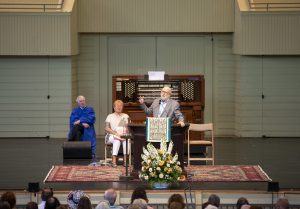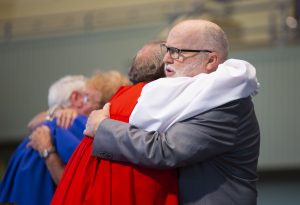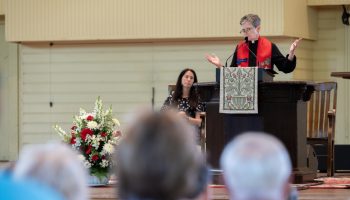
MHARI SHAW/STAFF PHOTOGRAPHER
“It took about eight centuries to give theological heft to what Father Francis intuited,” said Fr. Richard Rohr, OFM, at the 9:15 a.m. Thursday Ecumenical Service. “He gave subjectivity, ‘sacrality’ if you will, to everything.”
His sermon title was “Resolved from the Beginning,” and the Scripture reading was Ephesians 1:3-14.
“Francis gave everything voice,” Rohr said. “We are not talking subject to object, but subject to subject. You can’t discover the soul in something else until you recognize your own.”
For Franciscans, the first Bible was nature, creation.
“And as I have reminded you every day,” Rohr said, “that has been going on for 13.6 billion years. Meister Eckhart said ‘every creature is a word of God and is a book about God.’ ”
Nothing divine ever dies.
“Christmas was already Easter; the problem was solved at the beginning,” Rohr said. “Resurrection is the logical conclusion to incarnation. Resurrection was not a one-time anomaly in Jesus. When I get all dressed up on Easter, the songs and responses are less than exciting. If you want to see people who are excited about the resurrection, go to the Orthodox.”
Rohr’s book, The Universal Christ: How a Forgotten Reality Can Change Everything We See, Hope For, and Believe, was supposed to be published in November 2018. It was delayed and John Dominic Crossan’s book, Resurrecting Easter: How the West Lost and the East Kept the Original Easter Vision, was published before Rohr’s. Crossan came to the same conclusion about Easter from art, that Rohr came to from theology.
“There were no paintings of the Resurrection for the first six centuries of the church,” Rohr said. “You can see from the art how the Eastern church kept the original Easter vision while the Western church lost it.”
In the Western church, the paintings show Jesus alone; “touchdown Jesus,” Rohr called him, with his hands in the air saying “Hallelujah.”
“Humans don’t tend to get excited about things that do not include them,” Rohr said.
Later, the paintings would feature some Easter lilies, “which don’t grow in Palestine,” Rohr said. There would be two stunned guards on one side of the tomb and two angels on the other, and Jesus with a white staff and banner attached.
“There was never a message on the banner,” Rohr said. “It was a giveaway that we didn’t know what the message was.”

In contrast, in the Eastern Orthodox icons of the Resurrection, Jesus is shown rising out of Hades, pulling Adam and Eve with him followed by many other souls. Above is a cloud of witnesses.
“Until people learned to read, they studied these icons intensely because they knew there was meaning in each detail,” Rohr said. “Half the people had halos, showing they had a higher consciousness, and the other half were ordinary folks. That is an image to say ‘Hallelujah’ about.”
Rohr repeated a story from his Sunday sermon. In third grade, Rohr asked his teacher, “Sister, Jesus descended into Hell — why?” The nun replied, “to get Noah and Abraham.”
“That didn’t make sense to me,” he said. “Why were they in Hell? Both Pope John Paul II and Pope Benedict XVI have said that Hell is not a geographic place, but a state of consciousness. We got trapped in a place; we had to prove it was there, then we had to prove people were there, and they were always ‘those other people.’ Hades is simply the place of the dead, more like limbo.”
What happened to Jesus began the final chapter of history, Rohr said.
“There should be joy, but this generation was raised with Late, Great Planet Earth and ‘Armageddon,’ ” Rohr said. “There is cynicism today because people don’t know the Gospel.”
Quoting from the movie “The Best Exotic Marigold Hotel,” Rohr said, “everything will be alright in the end, and if it is not alright, then it is not the end.”
Rohr said he wanted “(his) lightweight talk to have some heft.” 1 Corinthians 15:12-20 is a discussion of resurrection. Paul wrote that if there was no such thing as resurrection, then Christ was not raised.
“Resurrection is a universal principle,” Rohr said. “Maybe it is our parenting, but we tend to remember threats better, and verse 14 says that our preaching is useless if Christ was not raised.”
In verse 20, Paul affirms that Christ was raised: “The first fruits of those who have died.”
“Scientists tell us that there are the same amount of atoms now as there were three seconds after the Big Bang,” Rohr said. “Those atoms keep getting rearranged, and resurrection is the facilitator of the change. Trust in a God-soaked future, soaked from the beginning, chosen from the beginning.”
The Rev. J. Paul Womack presided. Alison Marthinsen, part of a six-generation Chautauqua family, a volunteer for the Chautauqua Fund, part of the Chautauqua Choir and a member of the board of Smith Memorial Library, read the Scriptures. Barbara Hois, flute, George Wolfe, saxophone and Joseph Musser, piano, played “Two Romances and a Waltz” by Théodore Dubois and Charles Koechlin as the prelude. The Motet Choir sang “Steal Away,” arranged by Howard Helvey, as the anthem. George Wolfe served as saxophone soloist. Jared Jacobsen, organist and coordinator of worship and sacred music, directed the choir. The Alison and Craig Marthinsen Endowment for the Department of Religion provides support for this week’s services.




